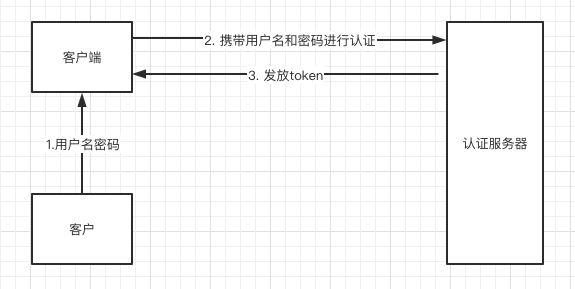做过权限认证的朋友都清楚,SpringSecurity 的功能很强大,但是我们也都知道,它配置起来也着实让人头疼。N多个配置类还有N多个需要实现的接口,总是记不住和不知道为什么会有这么多,最近在学习这方面的东西,正好能够把学习到的东西分享出来给大家参考一下。
在目前网上的很多博文中,只是把配置文件贴出来,根本没告诉为什么这么配置,都需要配置哪些东西。其实我们在理解了一些远离之后,就能够笔记哦啊清晰的去记住这些配置文件。
1. Oauth2.0 的使用
简介
OAuth 2.0是用于授权的行业标准协议。OAuth 2.0为简化客户端开发提供了特定的授权流,包括Web应用、桌面应用、移动端应用等。
名词含义
- Resource owner(资源拥有者):拥有该资源的最终用户,他有访问资源的账号密码;
- Resource server(资源服务器):拥有受保护资源的服务器,如果请求包含正确的访问令牌,可以访问资源;
- Client(客户端):访问资源的客户端,会使用访问令牌去获取资源服务器的资源,可以是浏览器、移动设备或者服务器;
- Authorization server(认证服务器):用于认证用户的服务器,如果客户端认证通过,发放访问资源服务器的令牌。
授权模式
- Authorization Code(授权码模式):正宗的OAuth2的授权模式,客户端先将用户导向认证服务器,登录后获取授权码,然后进行授权,最后根据授权码获取访问令牌;
- Implicit(简化模式):和授权码模式相比,取消了获取授权码的过程,直接获取访问令牌;
- Resource Owner Password Credentials(密码模式):客户端直接向用户获取用户名和密码,之后向认证服务器获取访问令牌;
- Client Credentials(客户端模式):客户端直接通过客户端认证(比如client_id和client_secret)从认证服务器获取访问令牌。
两种比较常用的授权模式
授权码模式

密码模式

使用
授权码的方式进行使用
应用场景:
为了理解OAuth的适用场合,让我举一个假设的例子。
有一个"云冲印"的网站,可以将用户储存在Google的照片,冲印出来。用户为了使用该服务,必须让"云冲印"读取自己储存在Google上的照片。
问题是只有得到用户的授权,Google才会同意"云冲印"读取这些照片。那么,"云冲印"怎样获得用户的授权呢?
传统方法是,用户将自己的Google用户名和密码,告诉"云冲印",后者就可以读取用户的照片了。这样的做法有以下几个严重的缺点。
(1)"云冲印"为了后续的服务,会保存用户的密码,这样很不安全。
(2)Google不得不部署密码登录,而我们知道,单纯的密码登录并不安全。
(3)"云冲印"拥有了获取用户储存在Google所有资料的权力,用户没法限制"云冲印"获得授权的范围和有效期。
(4)用户只有修改密码,才能收回赋予"云冲印"的权力。但是这样做,会使得其他所有获得用户授权的第三方应用程序全部失效。
(5)只要有一个第三方应用程序被破解,就会导致用户密码泄漏,以及所有被密码保护的数据泄漏。
OAuth就是为了解决上面这些问题而诞生的。
依赖:
<dependency>
<groupId>org.springframework.boot</groupId>
<artifactId>spring-boot-starter-security</artifactId>
</dependency>
<dependency>
<groupId>org.springframework.cloud</groupId>
<artifactId>spring-cloud-starter</artifactId>
</dependency>
<dependency>
<groupId>org.projectlombok</groupId>
<artifactId>lombok</artifactId>
<optional>true</optional>
</dependency>
<dependency>
<groupId>org.springframework.cloud</groupId>
<artifactId>spring-cloud-starter-oauth2</artifactId>
</dependency>
<dependency>
<groupId>org.springframework.boot</groupId>
<artifactId>spring-boot-starter-web</artifactId>
</dependency>
配置用户相关的service:
package com.macro.authdemo.service;
import org.springframework.beans.factory.annotation.Autowired;
import org.springframework.security.core.authority.AuthorityUtils;
import org.springframework.security.core.userdetails.User;
import org.springframework.security.core.userdetails.UserDetails;
import org.springframework.security.core.userdetails.UserDetailsService;
import org.springframework.security.core.userdetails.UsernameNotFoundException;
import org.springframework.security.crypto.password.PasswordEncoder;
import org.springframework.stereotype.Service;
import javax.annotation.PostConstruct;
import java.util.*;
@Service
public class UserService implements UserDetailsService {
private List<User> users;
@Autowired
private PasswordEncoder passwordEncoder;
@PostConstruct
public void init() {
users = new LinkedList<>();
String password = passwordEncoder.encode("admin");
users.add(new User("aaa", password, AuthorityUtils.commaSeparatedStringToAuthorityList("admin")));
users.add(new User("bbb", password, AuthorityUtils.commaSeparatedStringToAuthorityList("client")));
users.add(new User("ccc", password, AuthorityUtils.commaSeparatedStringToAuthorityList("client")));
}
@Override
public UserDetails loadUserByUsername(String s) throws UsernameNotFoundException {
for (User u : users) {
if (Objects.equals(u.getUsername(), s)) {
return u;
}
}
throw new UsernameNotFoundException("用户名不存在");
}
}
配置spring-security:
package com.macro.authdemo.config;
import org.springframework.context.annotation.Bean;
import org.springframework.context.annotation.Configuration;
import org.springframework.security.authentication.AuthenticationManager;
import org.springframework.security.config.annotation.web.builders.HttpSecurity;
import org.springframework.security.config.annotation.web.configuration.EnableWebSecurity;
import org.springframework.security.config.annotation.web.configuration.WebSecurityConfigurerAdapter;
import org.springframework.security.crypto.bcrypt.BCryptPasswordEncoder;
import org.springframework.security.crypto.password.PasswordEncoder;
@Configuration
@EnableWebSecurity
public class SpringSecurityConfig extends WebSecurityConfigurerAdapter {
@Bean
public PasswordEncoder passwordEncoder() {
return new BCryptPasswordEncoder();
}
@Bean
public AuthenticationManager authenticationManagerBean() throws Exception {
return super.authenticationManagerBean();
}
@Override
protected void configure(HttpSecurity http) throws Exception {
http.csrf()
.disable()
.authorizeRequests()
.antMatchers("/oauth/**", "/login/**", "/logout/**")
.permitAll()
.anyRequest()
.authenticated()
.and()
.formLogin()
.permitAll();
}
}
配置资源服务器:
package com.macro.authdemo.config;
import org.springframework.context.annotation.Configuration;
import org.springframework.security.config.annotation.web.builders.HttpSecurity;
import org.springframework.security.oauth2.config.annotation.web.configuration.EnableResourceServer;
import org.springframework.security.oauth2.config.annotation.web.configuration.ResourceServerConfigurerAdapter;
@Configuration
@EnableResourceServer
public class ResourceServerConfig extends ResourceServerConfigurerAdapter {
@Override
public void configure(HttpSecurity http) throws Exception {
http.authorizeRequests()
.anyRequest()
.authenticated()
.and()
.requestMatchers()
.antMatchers("/user/**");//配置需要保护的资源路径
}
}
Tips: 这里有一个问题,在spring-security的配置中,我们设置了资源的路径和权限,在资源服务器的配置中我们幼设置了一遍,这样的话,是不是重复了,我翻看了一些开源项目的单点登录相关的配置,里面鲜有对资源服务器的配置,这样的话也就是说可以只需要配置security的资源配置就能够达到效果。后面的工程应该是两个合成一个
认证服务的配置:
package com.macro.authdemo.config;
import com.macro.authdemo.service.UserService;
import org.springframework.beans.factory.annotation.Autowired;
import org.springframework.beans.factory.annotation.Qualifier;
import org.springframework.context.annotation.Configuration;
import org.springframework.security.authentication.AuthenticationManager;
import org.springframework.security.crypto.password.PasswordEncoder;
import org.springframework.security.oauth2.config.annotation.configurers.ClientDetailsServiceConfigurer;
import org.springframework.security.oauth2.config.annotation.web.configuration.AuthorizationServerConfigurerAdapter;
import org.springframework.security.oauth2.config.annotation.web.configuration.EnableAuthorizationServer;
import org.springframework.security.oauth2.config.annotation.web.configurers.AuthorizationServerEndpointsConfigurer;
import org.springframework.security.oauth2.config.annotation.web.configurers.AuthorizationServerSecurityConfigurer;
import org.springframework.security.oauth2.provider.token.TokenStore;
import org.springframework.security.oauth2.provider.token.store.JwtAccessTokenConverter;
import org.springframework.security.oauth2.provider.token.store.JwtTokenStore;
@Configuration
@EnableAuthorizationServer
public class AuthServerConfig extends AuthorizationServerConfigurerAdapter {
@Autowired
private PasswordEncoder passwordEncoder;
@Autowired
private UserService service;
@Autowired
private AuthenticationManager authenticationManager;
@Override
public void configure(ClientDetailsServiceConfigurer clients) throws Exception {
clients.inMemory()
.withClient("admin")
.secret(passwordEncoder.encode("admin123"))
.accessTokenValiditySeconds(3600)
.refreshTokenValiditySeconds(86400)
.redirectUris("http://www.baidu.com")
.scopes("all")
.authorizedGrantTypes("authorization_code", "password");
}
/**
* @author: ynzhang
* @Date: 2021/2/22 11:42 上午
* @Description: 密码的配置
*/
@Override
public void configure(AuthorizationServerEndpointsConfigurer endpoints) throws Exception {
endpoints.authenticationManager(authenticationManager)
.userDetailsService(service);
}
}
测试接口:
package com.macro.authdemo.controller;
import org.springframework.security.core.Authentication;
import org.springframework.web.bind.annotation.GetMapping;
import org.springframework.web.bind.annotation.RequestMapping;
import org.springframework.web.bind.annotation.RestController;
@RestController
@RequestMapping("/user")
public class UserController {
@GetMapping("getUser")
public Object getUser(Authentication authentication) {
return authentication.getPrincipal();
}
}
进行登陆认证
输入用户名aaa密码admin之后
认证服务器会重定向到你设置的重定向地址www.baidu.com并且携带code参数
然后再根据返回的code去请求(POST请求)http://localhost:9401/oauth/token
请求参数
parameters.add("grant_type", "authorization_code");
parameters.add("client_id", "portal-app");
parameters.add("client_secret", "123456");
parameters.add("code", code);
parameters.add("redirect_uri", "www.baidu.com");
之后就会返回token。
密码模式登陆
直接访问(POST请求)http://localhost:9401/oauth/token
请求参数
parameters.add("grant_type", "password"); parameters.add("username", "aaa"); parameters.add("password", "admin"); parameters.add("scope", "all");之后就会返回token
2. 配合Jwt的使用
其实根据上面的说法,token已经拿到了,但是认证服务的token存放在哪里了呢?答案是存放在内存中了,如果以后有多个用户,多个系统,多个角色,这种token都存在内存中,甚至说认证服务做分布式后,怎么办呢?存放在内存中就不合适了。这样的话Jwt就显得很必要了,我们可以根据生成的token和用户信息使用signature进行加密,等到客户端传递过来,采用signature进行解析就好了,完美解决了token需要存储的问题;当然,我们还可以配置把token放在redis中。
JWT简介
JWT是JSON WEB TOKEN的缩写,它是基于 RFC 7519 标准定义的一种可以安全传输的的JSON对象,由于使用了数字签名,所以是可信任和安全的。
JWT的组成
JWT token的格式:header.payload.signature;
header中用于存放签名的生成算法;
{ "alg": "HS256", "typ": "JWT" }payload中用于存放数据,比如过期时间、用户名、用户所拥有的权限等;
{ "exp": 1572682831, "user_name": "macro", "authorities": [ "admin" ], "jti": "c1a0645a-28b5-4468-b4c7-9623131853af", "client_id": "admin", "scope": [ "all" ] }signature为以header和payload生成的签名,一旦header和payload被篡改,验证将失败。
JWT实例
这是一个JWT的字符串:
eyJhbGciOiJIUzI1NiIsInR5cCI6IkpXVCJ9.eyJleHAiOjE1NzI2ODI4MzEsInVzZXJfbmFtZSI6Im1hY3JvIiwiYXV0aG9yaXRpZXMiOlsiYWRtaW4iXSwianRpIjoiYzFhMDY0NWEtMjhiNS00NDY4LWI0YzctOTYyMzEzMTg1M2FmIiwiY2xpZW50X2lkIjoiYWRtaW4iLCJzY29wZSI6WyJhbGwiXX0.x4i6sRN49R6JSjd5hd1Fr2DdEMBsYdC4KB6Uw1huXPgCopy to clipboardErrorCopied
- 可以在该网站上获得解析结果:https://jwt.io/
- 使用redis来存token(这种方式并没有对token进行加密)
配置文件中修改redis的信息
server.port=8080
spring.redis.host=39.102.83.104
spring.redis.port=6699
增加配置类:
package com.macro.authdemo.config;
import org.springframework.beans.factory.annotation.Autowired;
import org.springframework.context.annotation.Bean;
import org.springframework.context.annotation.Configuration;
import org.springframework.data.redis.connection.RedisConnectionFactory;
import org.springframework.security.oauth2.provider.token.TokenStore;
import org.springframework.security.oauth2.provider.token.store.redis.RedisTokenStore;
@Configuration
public class RedisTokenStoreConfig {
@Autowired
private RedisConnectionFactory connectionFactory;
@Bean
public TokenStore redisTokenStore() {
return new RedisTokenStore(connectionFactory);
}
}
认证服务中增加:
package com.macro.authdemo.config;
import com.macro.authdemo.service.UserService;
import org.springframework.beans.factory.annotation.Autowired;
import org.springframework.beans.factory.annotation.Qualifier;
import org.springframework.context.annotation.Configuration;
import org.springframework.security.authentication.AuthenticationManager;
import org.springframework.security.crypto.password.PasswordEncoder;
import org.springframework.security.oauth2.config.annotation.configurers.ClientDetailsServiceConfigurer;
import org.springframework.security.oauth2.config.annotation.web.configuration.AuthorizationServerConfigurerAdapter;
import org.springframework.security.oauth2.config.annotation.web.configuration.EnableAuthorizationServer;
import org.springframework.security.oauth2.config.annotation.web.configurers.AuthorizationServerEndpointsConfigurer;
import org.springframework.security.oauth2.config.annotation.web.configurers.AuthorizationServerSecurityConfigurer;
import org.springframework.security.oauth2.provider.token.TokenStore;
import org.springframework.security.oauth2.provider.token.store.JwtAccessTokenConverter;
import org.springframework.security.oauth2.provider.token.store.JwtTokenStore;
@Configuration
@EnableAuthorizationServer
public class AuthServerConfig extends AuthorizationServerConfigurerAdapter {
@Autowired
private PasswordEncoder passwordEncoder;
@Autowired
private UserService service;
@Autowired
private AuthenticationManager authenticationManager;
@Autowired
@Qualifier("redisTokenStore")
private TokenStore tokenStore;
// @Autowired
// @Qualifier("jwtTokenStore")
// private TokenStore tokenStore;
// @Autowired
// private JwtAccessTokenConverter jwtAccessTokenConverter;
@Override
public void configure(ClientDetailsServiceConfigurer clients) throws Exception {
clients.inMemory()
.withClient("admin")
.secret(passwordEncoder.encode("admin123"))
.accessTokenValiditySeconds(3600)
.refreshTokenValiditySeconds(86400)
.redirectUris("/oauth/getToken")
.scopes("all")
.authorizedGrantTypes("authorization_code", "password");
}
/**
* @author: ynzhang
* @Date: 2021/2/22 11:42 上午
* @Description: 密码的配置
*/
@Override
public void configure(AuthorizationServerEndpointsConfigurer endpoints) throws Exception {
endpoints.authenticationManager(authenticationManager)
.userDetailsService(service)
.tokenStore(tokenStore);
// .accessTokenConverter(jwtAccessTokenConverter);
// endpoints.authenticationManager(authenticationManager)
// .userDetailsService(service);
}
}
Jwt存放token
增加配置类:
package com.macro.authdemo.config; import org.springframework.context.annotation.Bean; import org.springframework.context.annotation.Configuration; import org.springframework.context.annotation.Primary; import org.springframework.security.oauth2.provider.token.TokenStore; import org.springframework.security.oauth2.provider.token.store.JwtAccessTokenConverter; import org.springframework.security.oauth2.provider.token.store.JwtTokenStore; @Configuration public class JwtTokenStoreConfig { @Bean @Primary public TokenStore jwtTokenStore() { return new JwtTokenStore(jwtAccessTokenConverter()); } @Bean public JwtAccessTokenConverter jwtAccessTokenConverter() { final JwtAccessTokenConverter jwtAccessTokenConverter = new JwtAccessTokenConverter(); jwtAccessTokenConverter.setSigningKey("test_key");//这里使用的是对称加密,其实可以使用非对称加密 return jwtAccessTokenConverter; } }修改认证服务:
```java
package com.macro.authdemo.config;import com.macro.authdemo.service.UserService;
import org.springframework.beans.factory.annotation.Autowired;
import org.springframework.beans.factory.annotation.Qualifier;
import org.springframework.context.annotation.Configuration;
import org.springframework.security.authentication.AuthenticationManager;
import org.springframework.security.crypto.password.PasswordEncoder;
import org.springframework.security.oauth2.config.annotation.configurers.ClientDetailsServiceConfigurer;
import org.springframework.security.oauth2.config.annotation.web.configuration.AuthorizationServerConfigurerAdapter;
import org.springframework.security.oauth2.config.annotation.web.configuration.EnableAuthorizationServer;
import org.springframework.security.oauth2.config.annotation.web.configurers.AuthorizationServerEndpointsConfigurer;
import org.springframework.security.oauth2.config.annotation.web.configurers.AuthorizationServerSecurityConfigurer;
import org.springframework.security.oauth2.provider.token.TokenStore;
import org.springframework.security.oauth2.provider.token.store.JwtAccessTokenConverter;
import org.springframework.security.oauth2.provider.token.store.JwtTokenStore;@Configuration
@EnableAuthorizationServer
public class AuthServerConfig extends AuthorizationServerConfigurerAdapter {@Autowired private PasswordEncoder passwordEncoder; @Autowired private UserService service; @Autowired private AuthenticationManager authenticationManager;// @Autowired
// @Qualifier("redisTokenStore")
// private TokenStore tokenStore;@Autowired @Qualifier("jwtTokenStore") private TokenStore tokenStore; @Autowired private JwtAccessTokenConverter jwtAccessTokenConverter;
@Override
public void configure(ClientDetailsServiceConfigurer clients) throws Exception {
clients.inMemory()
.withClient("admin")
.secret(passwordEncoder.encode("admin123"))
.accessTokenValiditySeconds(3600)
.refreshTokenValiditySeconds(86400)
.redirectUris("/oauth/getToken")
.scopes("all")
.authorizedGrantTypes("authorization_code", "password");
}
/**
* @author: ynzhang
* @Date: 2021/2/22 11:42 上午
* @Description: 密码的配置
*/
@Override
public void configure(AuthorizationServerEndpointsConfigurer endpoints) throws Exception {
endpoints.authenticationManager(authenticationManager)
.userDetailsService(service)
.tokenStore(tokenStore)
.accessTokenConverter(jwtAccessTokenConverter);
// endpoints.authenticationManager(authenticationManager)
// .userDetailsService(service);
}
}
上面代码中提到了对称加密和非对称加密的问题
对称加密,就像上面的程序一样,`jwtAccessTokenConverter.setSigningKey("test_key")`加密的时候使用的是这个字符串,等从客户端传过来的时候解码用的也是这个字符串,这种模式就是对称加密的模式。
而相对的非对称加密的模式,就是采用使用公钥进行加密,解密的时候采用私钥,这种就称为非对称加密
具体的设置如下:
Jwt的配置类:
```java
package com.macro.authdemo.config;
import org.springframework.context.annotation.Bean;
import org.springframework.context.annotation.Configuration;
import org.springframework.context.annotation.Primary;
import org.springframework.security.oauth2.provider.token.TokenStore;
import org.springframework.security.oauth2.provider.token.store.JwtAccessTokenConverter;
import org.springframework.security.oauth2.provider.token.store.JwtTokenStore;
@Configuration
public class JwtTokenStoreConfig {
@Bean
@Primary
public TokenStore jwtTokenStore() {
return new JwtTokenStore(jwtAccessTokenConverter());
}
@Bean
public JwtAccessTokenConverter jwtAccessTokenConverter() {
final JwtAccessTokenConverter jwtAccessTokenConverter = new JwtAccessTokenConverter();
jwtAccessTokenConverter.setKeyPair(keyPair());;//这里使用的是非对称加密,其实可以使用非对称加密
return jwtAccessTokenConverter;
}
@Bean
public KeyPair keyPair() {
//从classpath下的证书中获取秘钥对
KeyStoreKeyFactory keyStoreKeyFactory = new KeyStoreKeyFactory(new ClassPathResource("jwt.jks"), "123456".toCharArray());
return keyStoreKeyFactory.getKeyPair("jwt", "123456".toCharArray());
}
}